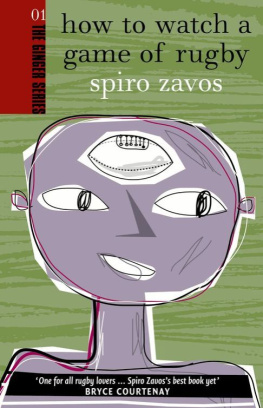Expanded edition originally published in 1978 by the Institute for the Study of Human Issues. Original edition published 1967 by Prentice-Hall, Inc.
Published 1996 by Transaction Publishers
Published 2017 by Routledge
2 Park Square, Milton Park, Abingdon, Oxon OX14 4RN
711 Third Avenue, New York, NY 10017, USA
Routledge is an imprint of the Taylor & Francis Group, an informa business
New material this edition copyright 1996 by Taylor & Francis.
All rights reserved. No part of this book may be reprinted or reproduced or utilised in any form or by any electronic, mechanical, or other means, now known or hereafter invented, including photocopying and recording, or in any information storage or retrieval system, without permission in writing from the publishers.
Notice:
Product or corporate names may be trademarks or registered trademarks, and are used only for identification and explanation without intent to infringe.
Library of Congress Catalog Number: 95-50654
Library of Congress Cataloging-in-Publication Data
Spiro, Melford E.
Burmese supernaturalism / Melford E. Spiro; with a new introductior
the author. Expanded ed.
p. cm.
Originally published: Philadelphia: Institute for the Study of Human
sues, 1978.
Includes bibliographical references and index.
ISBN 1-56000-882-2 (pbk.: alk. paper)
1. BurmaReligious life and customs. 2. AnimismBurma.
3. Supernatural. I. Title.
BL2051.S66 1996
291.1'09591dc20 95-50654
CIP
ISBN 13: 978-1-56000-882-8 (pbk)
The worldview of most of the world's great civilizations is informed not by one, but by two or more religious traditionsan indigenous religion, and at least one other brought in from outside. In some cases, elements from each have been combined in various ways and in various proportions to produce one syncretistic religion. Thus, although Catholicism is the dominant religion in Latin America, it is a Catholicism that represents a syncretism of Christian, indigenous, and African elements, in which the Christian, however, is hegemonic. In other cases, the different religions remain distinct, and devotees profess allegiance to both. The Japanese, for example, worship both at Buddhist temples and (pre-Buddhist) Shinto shrines.
An analogous situation obtains in Burma (now called Myanmar), as well as the other societies of mainland Southeast Asia, in which the religious landscape includes both an indigenous spiri cult and one of the great world religions, Buddhism, an import from India. The spirit cults are often referred to as a "folk religion," not however because their devotees are ordinary folk whereas the elite are devotees of Buddhismall are devotees of bothbut because the former is based on an oral, the latter on a written tradition. Since I have described Theravada Buddhism in my Buddhism and Society: A Great Tradition and Its Burmese Vicissitudes, this book deals instead with the Burmese spirit cult.
For reasons adduced in the following chapters, the spirit cult and Buddhism are, in my view, two separate, albeit interrelated religions, not a single syncretistic one. Since, however, this "two religions thesis" (as it has since been dubbed) has engendered much controversy among Southeast Asian scholars, much of the Preface to the Expanded Edition of this book examines this controversy. Hence, here I wish to examine two other issues, one substantive, the other theoretical, related to my treatment of the spirit cult. I shall begin with the former.
In rereading this book I was struck by the fact, which I was not when I wrote it, that fully half the text is devoted to what today would be called "traditional medicine." Thus, to describe the theology of this folk religion is, from our point of view, to describe inter alia a theory of illness, and to describe its rituals is to describe inter alia a technology of healing. That is, the malevolent supernatural beings of this religion (witches, ghosts, demons, and punitive spirits) are the supernatural agents of "illness," mostly "mental illness"; its benevolent supernatural beings are the supernatural agents of "healing"; and its ritual specialists are the human agents of "healing."
That being so it could now be suggested that rather than conceiving of this book as a study of a folk religion, I might have conceived of it instead as a study of folk medicine; and by means of a somewhat different Introduction, a different conceptual emphasis, and a different organization, the book might then have been titled not Burmese Supernaturalism, but Burmese Medicine. That I did not so conceive of it, however, is that while illness and healing, again from our point of view, constitute important elements of the spirit cult, nevertheless the Burmese themselves do not regard it as a medical system. This is not because the concept of a medical system, distinct and separate from other cultural systems, is unfamiliar to them. On the contrary, Burmese villagers, let alone city folk, know of and participate in, not only one, but two medical systems, both explicitly recognized and designated as such: indigenous (herbal) medicine and Western (or, as it is sometimes called) cosmopolitan medicine, each with its own physicians, diagnostic methods, therapeutic techniques, and pharmacopoeia.
Despite the fact that the spirit cult also deals with illness and healing, nevertheless the Burmese do not regard it as a medical system any more than Pentecostal Christianity (which is explicitly conceived as dealing with illness and healing) is regarded by its followers as a medical system. Rather, both are regarded as religious systems, not only because illness and healing is a byproduct of their central concern with religious issues, but also because they are dealt with in a "religious," not a "medical" mode. Let us examine this proposition as it applies to the spirit cult.
As I have already noted, it is mental illness (as we would call it) that is the concern of the spirit cult, whereas physical illness is the concern of the two medical systems. That being so, it might be argued that in Burma, contrary to what I have said, the spirit cult is not separate from, but is a part of, the cultural domain of medicine, within which, however, there is, as there is in the West, a division of labor: physical illness is treated by indigenous and Western medical specialists, while mental illness is treated by the cult (i.e., ritual) specialist. Hence, from that point of viewthe standard view of medical anthropology the ritual specialist may be regarded as a psychiatrist or psychotherapist.
I do not find this argument convincing on two accounts. Thus, the person whom a Western psychotherapist would view as suffering from some form of mental illness, is viewed by the cult specialist as suffering, instead, from witchcraft or spirit possession; in short, for him such a person is not a patient, but a victim. Moreover, whereas the Western psychotherapist would regard a patient's belief that he has been bewitched or possessed as a symptom, a paranoid delusion, and would attempt to cure him of it, the cult specialist regards such a belief as veridical, and hence attempts to drive out or drive off the supernatural culprit. In sum, the cult specialist is an exorcist, not a psychotherapist. This is not to deny that exorcism, from our point of view, may have therapeutic functions; it does, indeed, and I explicitly discuss such functions in some detail. But to therefore designate the Burmese exorcist as a psychotherapist makes no more sense than to designate a Roman Catholic exorcist as one. In neither case do the exorcists themselves, their clients, or their flock conceive of the exorcistic role in this way.














